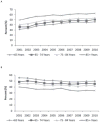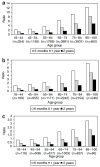Optimal hemodialysis vascular access in the elderly patient
- PMID: 23173892
- PMCID: PMC3999348
- DOI: 10.1111/sdi.12037
Optimal hemodialysis vascular access in the elderly patient
Abstract
The optimal vascular access for elderly patients remains a challenge due to the difficulty balancing the benefits and risks in a population with increased comorbidity and decreased survival. Age is commonly associated with failure to mature in fistula and decreased rates of primary and secondary patency in both fistula and grafts. In the elderly, at 1 and 2 years, primary patency rates range from 43% to 74% and from 29% to 67%, respectively. Secondary patency rates at 1 and 2 years range from 56% to 82% and 44% to 67%, respectively. Cumulative fistula survival is no better than grafts survival when primary failures are included. Several observational studies consistently demonstrate a lower adjusted mortality among those using a fistula compared with a catheter; however, catheter use in the elderly is increasing in most countries with the exception of Japan. Both guidelines and quality initiatives do not acknowledge the trade-offs involved in managing the elderly patients with multiple chronic conditions and limited life expectancy or the value that patients place on achieving these outcomes. The framework for choice of vascular access presented in this article considers: (1) likelihood of disease progression before death, (2) patient life expectancy, (3) risks and benefits by vascular access type, and (4) patient preference. Future studies evaluating the timing and type of vascular access with careful assessments of complications, functionality, cost benefit, and patients' preference will provide relevant information to individualize and optimize care to improve morbidity, mortality, and quality of life in the elderly patient.
© 2012 Wiley Periodicals, Inc.
Figures



Similar articles
-
Vascular Access Type and Clinical Outcomes among Elderly Patients on Hemodialysis.Clin J Am Soc Nephrol. 2017 Nov 7;12(11):1823-1830. doi: 10.2215/CJN.01410217. Epub 2017 Aug 10. Clin J Am Soc Nephrol. 2017. PMID: 28798220 Free PMC article.
-
Hemodialysis vascular access in the elderly-getting it right.Kidney Int. 2019 Jan;95(1):38-49. doi: 10.1016/j.kint.2018.09.016. Kidney Int. 2019. PMID: 30606427 Review.
-
[Analysis of the survival of permanent vascular access ports].Nefrologia. 2001 May-Jun;21(3):260-73. Nefrologia. 2001. PMID: 11471307 Spanish.
-
Vascular access for hemodialysis in the elderly.J Vasc Surg. 2019 Feb;69(2):517-525.e1. doi: 10.1016/j.jvs.2018.05.219. J Vasc Surg. 2019. PMID: 30683199
-
Vascular access in elderly patients with end-stage renal disease.Int Urol Nephrol. 2008;40(4):1133-42. doi: 10.1007/s11255-008-9464-2. Epub 2008 Sep 16. Int Urol Nephrol. 2008. PMID: 18792799 Review.
Cited by
-
Maintaining a viable vascular access for hemodialysis in an elderly person with diabetes: a journey to live, not just to stay alive.Clin Case Rep. 2016 Jan 4;4(2):203-8. doi: 10.1002/ccr3.459. eCollection 2016 Feb. Clin Case Rep. 2016. PMID: 26862425 Free PMC article.
-
Renal function, uraemia and early arteriovenous fistula failure.BMC Nephrol. 2014 Nov 17;15:179. doi: 10.1186/1471-2369-15-179. BMC Nephrol. 2014. PMID: 25403339 Free PMC article.
-
Prevalence and clinical significance of anatomic variant in cephalic arch on preoperative mapping venography.Sci Rep. 2022 Oct 17;12(1):17398. doi: 10.1038/s41598-022-22372-0. Sci Rep. 2022. PMID: 36253400 Free PMC article.
-
Review of antimicrobial use and considerations in the elderly population.Clin Interv Aging. 2018 Apr 17;13:657-667. doi: 10.2147/CIA.S133640. eCollection 2018. Clin Interv Aging. 2018. PMID: 29713150 Free PMC article. Review.
-
Prevention of tunneled cuffed catheter dysfunction with prophylactic use of a taurolidine urokinase lock: A randomized double-blind trial.PLoS One. 2021 May 20;16(5):e0251793. doi: 10.1371/journal.pone.0251793. eCollection 2021. PLoS One. 2021. PMID: 34015014 Free PMC article. Clinical Trial.
References
-
- Polkinghorne KR, McDonald SP, Atkins RC, Kerr PG. Vascular access and all-cause mortality: a propensity score analysis. J Am Soc Nephrol. 2004;15(2):477–486. - PubMed
-
- Astor BC, Eustace JA, Powe NR, Klag MJ, Fink NE, Coresh J. Type of vascular access and survival among incident hemodialysis patients: the Choices for Healthy Outcomes in Caring for ESRD (CHOICE) Study. J Am Soc Nephrol. 2005;16(5):1449–1455. - PubMed
-
- Boyd CM, Darer J, Boult C, Fried LP, Boult L, Wu AW. Clinical practice guidelines and quality of care for older patients with multiple comorbid diseases: implications for pay for performance. JAMA. 2005;294(6):716–724. - PubMed
Publication types
MeSH terms
Grants and funding
LinkOut - more resources
Full Text Sources
Medical

